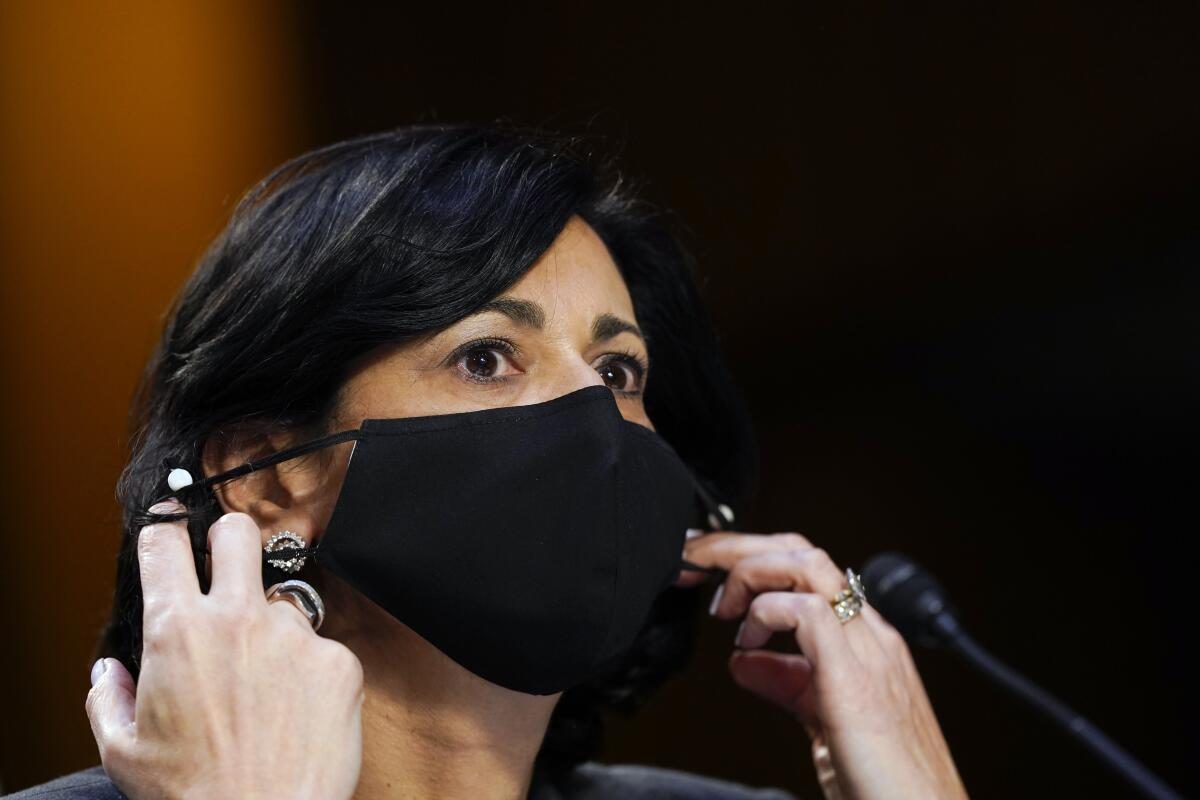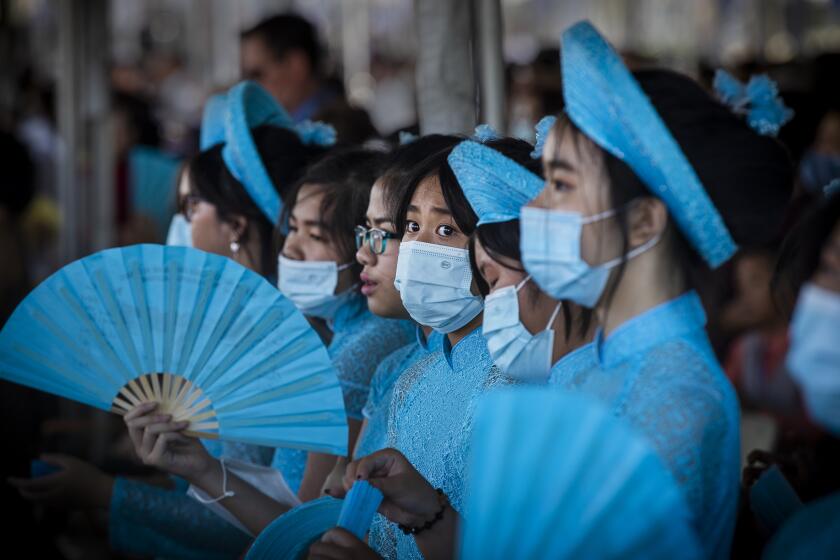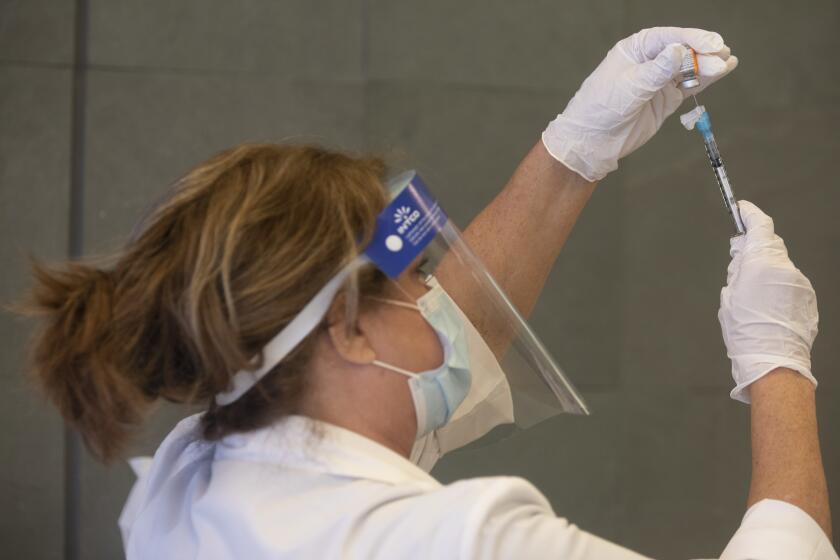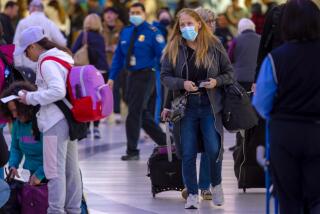CDC document paints more dire picture of threat posed by Delta variant

- Share via
A confidential document prepared by the Centers for Disease Control and Prevention about the highly transmissible Delta variant argues that even people who are fully vaccinated against COVID-19 will need to take more aggressive steps to get the country’s growing outbreak under control.
Mounting evidence indicates that the Delta variant is a more formidable foe than previously believed, largely due to its ability to infect and be spread by people who are fully vaccinated.
The CDC must “acknowledge the war has changed,” the document states.
The agency cites new data from an outbreak this month in Barnstable County, Mass., where 69% of eligible residents are vaccinated. Out of 469 cases tied to gatherings at restaurants, bars and vacation homes, 74% were so-called breakthrough infections in people who had been fully vaccinated. Among the 133 viral samples that were genetically sequenced, 90% were the Delta variant or an offshoot of the strain.
The confidential document also cites discouraging reports about breakthrough cases in India, where the variant was first detected. The viral loads of vaccinated people who became infected with Delta were higher than the viral loads of vaccinated people who were infected with other coronavirus strains, those reports found.
The growing evidence of Delta’s propensity to cause breakthrough infections is sure to complicate efforts to persuade vaccination holdouts to roll up their sleeves for the COVID-19 shots — a challenge the unnamed authors of the CDC document anticipate.
Going forward, health officials will have to “improve [the] public’s understanding of breakthrough infections” and stop “describing breakthrough cases as ‘rare’ or as a ‘small percentage’ of cases,” the document says.
By now, we all know that the Delta variant is about twice as transmissible as the original coronavirus. What exactly makes it so good at spreading?
The internal report was obtained by the Washington Post and posted on its website.
Experts still agree that COVID-19 vaccines offer the safest route out of the pandemic. Indeed, the document notes that as of Saturday, the rate of new infections was eight times higher among those who were not vaccinated than those who were, and the incidences of COVID-19 hospitalizations and deaths were 25 times higher for the unvaccinated.
But experts fear that if being vaccinated no longer comes with the privilege of being able to jettison face masks and social distancing, the shots will be a tougher sell for health officials to make.
“I don’t envy their position right now,” said Dr. Joshua Schiffer, an infectious-diseases specialist at Fred Hutch in Seattle.
Kendra Findley, the administrator of community health and epidemiology in Greene County, Mo., said the CDC can’t help changing its advice in response to new information — but the inconsistencies can make her job harder.
“We are trying to adapt and respond to this virus as it occurs,” she said. “Unfortunately, we’ve had to come up with the correct messaging and tell people how to protect themselves when we’re just learning about it.”
Some of the data in the CDC document were described this week by the agency’s director, Dr. Rochelle Walensky, when she announced new guidance regarding the use of face masks. In parts of the country where coronavirus transmission rates are “substantial” or “high,” everyone — regardless of vaccination status — should wear face coverings when they’re in indoor public spaces, the CDC now says.
The CDC recommends that even vaccinated people wear masks indoors in parts of the U.S. where the coronavirus is surging.
The Delta variant was already known to be about 50% more transmissible than the Alpha variant, which was first detected in the United Kingdom and is about 56% more transmissible than the original coronavirus that sparked the global pandemic.
“Delta is basically coronavirus on speed,” said Dr. Gregory Poland, an immunologist at the Mayo Clinic in Rochester, Minn.
Scientists have established that people infected with Delta have about 1,000 times more viral particles in their upper respiratory systems than people who are infected with earlier coronavirus strains.
That difference allows Delta to jump from person to person just four days after an initial infection, said Chunhuei Chi, director of the Center for Global Health at Oregon State University. With previous strains, it took about six days for that to occur, he said.
This rapid spread helps explain why the Delta variant, which is thought to have arrived in the U.S. in March, now accounts for 82% of recent coronavirus infections in the United States, according to CDC estimates.
The outbreak in Barnstable County, home of Cape Cod, sheds new light on Delta’s power to spread via vaccinated as well as unvaccinated people. On July 3, there were no known cases of coronavirus infections among residents there and hadn’t been for at least the previous two weeks. But by July 17, the area was averaging 177 cases per 100,000 people per day, according to a dispatch published Friday in the CDC’s Morbidity and Mortality Weekly Report.
Researchers tested the viral loads of 127 people who experienced breakthrough infections and found that they were essentially the same as for 84 other infected people who were unvaccinated. Five patients wound up needing hospital care; four of them were fully vaccinated.
The 469 cases detailed in the study do not include people in 22 other states who visited the vacation spot this month, nor any secondary infections that are still being traced. So far, no deaths have been tied to the outbreak.
The authors of the dispatch advised local authorities elsewhere to consider expanding their prevention strategies even if current transmission levels are low, since a single traveler could import the virus and spur an outbreak. They suggested universal masking indoors, putting caps on the size of gatherings and postponing public events if needed.
The Delta variant of the coronavirus has taken on a decidedly American feel, mainly targeting those who just won’t get vaccinated.
U.S. public health experts have watched the Delta variant’s path of destruction in the U.K. and India, many of them assuming that those patterns would not replay themselves here. Britain, after all, has made broad use of the AstraZeneca vaccine, which is much less effective against Delta, and virtually no one was vaccinated in India when the variant cropped up there.
The Cape Cod report changed all that, said Dr. Megan Ranney, a physician and associate dean at the Brown University School of Public Health.
“This is a real game changer,” she said.
Breakthrough cases are also rising in Los Angeles County, with fully vaccinated residents making up 20% of confirmed infections in people ages 16 and up in June and 26% of such cases in the first half of July, according to Public Health Director Barbara Ferrer.
Unlike in previous surges, which hit hardest in low-income, densely populated areas, the communities now experiencing the highest rates of transmission include downtown Los Angeles, West Hollywood, Beverly Hills, Venice, the Hollywood Hills and Studio City. Young adults are responsible for most of the spread, Ferrer said.
The Delta variant accounted for 84% of coronavirus samples sequenced in California this month, up from 53% in June and 5.9% in May, according to the state Department of Public Health.
Misinformation about COVID-19 vaccines is costing people their lives. We separate the myths from the reality.
Though Delta’s superspreading abilities have been clear for some time, scientists have not been sure whether infections caused by the variant are more dangerous. The CDC document cites three reports that link the variant with more serious health outcomes:
- In a preprint study from Ontario, Canada, people infected with Delta were more than twice as likely to be admitted to the hospital, nearly four times more likely to be treated in the intensive care unit and more than twice as likely to die of COVID-19 as people infected with earlier versions of the coronavirus.
- In a preprint report from Singapore, people infected with Delta were 4.9 times more likely to require oxygen treatment, be admitted to an ICU or die of COVID-19 than people who were infected in the initial months of the pandemic.
- In a peer-reviewed study from Scotland, the odds of needing hospital care were 85% greater for people with Delta infections than for people infected with other versions of the virus.
In another potentially ominous sign, the CDC document noted that among people who had weathered a coronavirus infection at least 180 days earlier, the risk of a subsequent infection with Delta was about 46% higher than the risk of a subsequent infection with the Alpha variant.
Not everyone found the data convincing. Neeraj Sood, a health policy expert at USC’s Sol Price School of Public Policy, said the CDC document relies heavily on studies that have small sample sizes and use viral load as a surrogate for disease, which may not necessarily be an accurate substitution.
“I didn’t look and say, ‘There’s a pretty bulletproof case that Delta is more virulent,’” he said.
Scientists have found 13 places in the human genome that may influence our susceptibility to a coronavirus infection or risk of severe COVID-19.
Sood said the CDC has also made the mistake of focusing too heavily on the rising number of breakthrough infections, which is to be expected when an increasing share of the population is vaccinated. Researchers should instead focus on how deeply the vaccines have driven down rates of severe illness and hospitalization among people who do get infected, he said.
“If it’s not going to kill you, not going to put you in the hospital, I’m less worried,” he said.
But with only 49.5% of the U.S. population fully vaccinated and a virus that replicates and transmits robustly even among those inoculated, conditions are ripe for new — and possibly more dangerous — variants to emerge.
“You couldn’t design a better experiment for creating a vaccine-resistant variant,” Ranney said.
Times staff writers Deborah Netburn and Luke Money contributed to this report.











